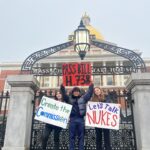The thin red line
By Charles P. Blair, Mila Johns | March 26, 2013
Both opposition forces and the Syrian government have alleged that chemical weapons were used in last Tuesday’s attack on the village of Khan al-Assal, bringing to the fore one of the most potentially far-reaching of the many dangers that have arisen during Syria’s civil war. Now entering its third year, the Syrian revolt — by far the longest uprising of the Arab Spring — is the first in history that threatens to violently topple a government armed with weapons of mass destruction (WMD).
Both opposition forces and the Syrian government have alleged that chemical weapons were used in last Tuesday’s attack on the village of Khan al-Assal, bringing to the fore one of the most potentially far-reaching of the many dangers that have arisen during Syria’s civil war. Now entering its third year, the Syrian revolt — by far the longest uprising of the Arab Spring — is the first in history that threatens to violently topple a government armed with weapons of mass destruction (WMD). This unique case naturally precipitates profound concerns that elements of Syria’s large stockpiles of chemical agents and munitions will find themselves in the hands of insurgents or terrorist groups. To date, however, the West has largely ignored the threat of non-state acquisition of such arms, instead focusing its concern around the use of chemical weapons by the regime of Bashar al-Assad.
With more than 70,000 dead and over one million Syrians displaced by civil war, international pressure mounts for more substantive intervention by Western powers. Even absent confirmed use of WMD, France and the United Kingdom are moving toward greater support of the disparate forces fighting the Assad regime.
In contrast, the United States has refrained from direct military support of the opposition. At the same time, President Obama has clearly, directly declared the use of chemical weapons in Syria as the red line that would call for substantive action from the United States. While avoiding any carte blanche backing of opposition forces that include significant numbers of jihadists and other terrorists, the US policy places significant emphasis on reinforcing the international moral norm against the use of weaponry that is considered “beyond the pale.” But recent allegations highlight the potential unintended consequences of this strategy: Khan al-Assal is the latest in a growing series of incidents in the country during which the use of chemical weapons has been claimed by either, or both, sides of the conflict.
Undoubtedly anticipating that violation of this boundary will spur American intervention, the Syrian rebels have significant motivation to charge the Assad regime with the use of chemical weapons. Conversely, the Syrian government has a vested interest in casting the rebels as a fringe element willing to use any means necessary to overthrow the regime, including violating the opprobrium against chemical weapons use. The extreme stakes created by the American red line make it is incumbent upon the United States to articulate precisely what is meant by the term chemical weapon — which, under international law, includes non-lethal agents as well as more well-known and lethal agents such as sarin and VX.
Given the general absence of foreign media from the conflict, reports of chemical attacks increasingly are based on citizen journalism. As Western news standards evolve with the growth of social media, the nuances that differentiate classes of chemical weapons appear to be dissolving. The public conflation of lethal and non-lethal chemical agents increasingly creates the perception that the United States has failed to act, despite evidence that President Obama’s red line has been crossed. In short, US policy may unintentionally have created a situation in which the public is desensitized to chemical weapons use, eroding the international taboo against them. To buttress and even strengthen that taboo, the United States now must make crystal clear to the international community what would and would not constitute crossing the chemical warfare red line, in Syria and elsewhere.
Many chemical weapons, no proven use. Most experts assume that the Assad regime possesses a vast and sophisticated chemical arsenal. Chemical agents most frequently cited as components of the Syrian arsenal include mustard gas, a blistering agent with properties that historically have generated large numbers of casualties, the vast majority requiring long-term medical care. A persistent chemical, mustard agent also creates long-term battlefield contamination. Vastly more toxic and lethal than mustard agent, sarin nerve agent is reportedly easily readied for use by the Syrian military for delivery via aircraft, artillery, and the country’s 100 to 200 Scud missiles. Syria likely also possesses VX nerve agents; several hundred times more lethal than sarin, VX is the most deadly of all chemical agents. Apart from these three agents, some experts expand their assessment of Syrian’s probable chemical arsenal to include choking agents such as chlorine gas and phosgene, which, according to a 1997 report by the US Surgeon General and US Army, was last used militarily in 1918. The latter agent, the effects of which appear only after a delay, was responsible for 80 percent of those killed by chemicals during World War I.
Last week’s incident in Khan al-Assal, the most dramatic to date, is the latest in a series of accusations of chemical weapons use by the Syrian opposition, with counterclaims by the Syrian regime. The attack is reported to have killed at least 31 people and injured more than 100; US and other Western officials place responsibility for the attack with the Syrian government. Still, among the dead were 16 pro-Assad soldiers, and Damascus blames opposition forces for the incident, claiming they used a rocket laden with chemicals. Government officials have requested a UN investigation into chemical weapons use in Tuesday’s incident “by the terrorists groups operating in Syria.” The same day, opposition forces reportedly claimed that Syrian “chemical rockets” had also struck the village of Ataibah near Damascus.
Before recent events, two purported chemical attacks in Homs in December 2012 generated unprecedented allegations of chemical weapons use, with some observers concluding that the American red line had been crossed. In the first instance, on December 6, victims were allegedly targeted with white phosphorus munitions fired by Syrian military helicopters. Two weeks later, on December 23, another incident occurred in Homs, killing at least seven and reportedly wounding more than 70; opposition forces assert that the attack used poisonous gases. Despite some journalistic assertions that nerve agents were responsible, a US State Department investigation concluded that no chemical weapons were used. Demonstrating the need to differentiate lethal and non-lethal chemical agents, US officials reportedly believe that casualties from the December 23 Homs incident are linked to Syrian military “misuse [of] a riot-control gas.”
No internationally sanctioned investigation has yet confirmed the use of chemical agents in any of these incidents. Unverified accounts and video footage of casualties purportedly caused by chemical weapons offer virtually no evidence that lethal chemical agents, including those agents likely constituting the Syrian arsenal, were used. Mustard agent, for example, dramatically affects the victim’s skin, eyes, and internal tracks. None of the filmed victims of last week’s Khan al-Assal attack evidenced the effects of such a blistering agent. Moreover, given its low volatility and high level of persistence, its presence would require victims to be handled with extreme care to avoid secondary contamination. Actions by medical staff treating the victims of the Khan al-Assal attack are incongruous with concerns about secondary contamination, and there are no known reports of subsequent negative health effects on first responders or hospital personnel. Similarly, the effects of sarin or VX nerve agents — manifest, for example, by a victim’s twitching — are absent from video of the Khan al-Assal incident. Like mustard agent, VX also is extremely persistent. Even sarin, which evaporates at a rate similar to water, is persistent enough to cause secondary contamination during transport and treatment in ambulances and hospitals, as evidenced during the response to a 1995 terror attack on the Tokyo subway. Doctors and civilians filmed at the Aleppo hospital treating the victims of the Khan al-Assal incident spoke of the agent emanating from the rocket, post-detonation, as being a powder. But choking agents, including chlorine (the smell of which reportedly was present at the Khan al-Assal attack), are delivered in a gaseous state.
No evidence yet exists to support the accusation that the Assad regime had used traditional chemical warfare agents — that is, those substances posing danger to humans and marked by exceptional lethality.
Evidence does point toward Syrian use of chemical agents designed to be non-lethal — those that are not entirely banned under the international law. With regard to the Chemical Weapons Convention (CWC), certain agents for purposes of “[l]aw enforcement including domestic riot-control purposes” are permitted. Riot-control agents, commonly lumped together in the public consciousness as tear gas or mace, cause rapid, short-lived irritation of the eyes, skin, and respiratory system, producing symptoms such as shortness of breath, choking, rashes, and temporary blindness due to swelling of the eyes. Riot-control agents are not banned under the CWC and are used by governments throughout the world, including the United States.
Loopholes in the CWC allow for use of other non-lethal agents, including so-called incapacitants, for domestic law enforcement and, in other interpretations, counterterrorism activities. In contrast to riot-control agents, the effects of incapacitants can last for days after exposure. Moreover, their effects are psychological or mental, designed to leave the victim confused, disabled, or, in general, ineffective. (Although Syria is not generally thought to possess such agents, some have theorized that the Assad regime may use incapacitants to test the waters of international reaction.) Also not addressed by the CWC is white phosphorus, an incendiary chemical agent that has been traditionally utilized by militaries to provide ground cover for operations as well as to illuminate targets. Its use as an offensive weapon lies in a legal gray area vis-a-vis chemical weapons law; it can produce severe chemical burns, irritation of mucus membranes (particularly of the eyes), and even death. From Homs forward to last week’s attack in Khan al-Assal, the symptoms displayed by victims of alleged chemical weapons are not of a severity that would evince white phosphorus use, though the mere mention of white phosphorus by a doctor treating victims of the Khan-al-Assad incident adds to the growing scrutiny of that chemical. Also, US responses to reports of Syrian use of white phosphorus are complicated by past American and Israeli military operations in which white phosphorus was used.
Strengthening the taboo. A disturbing pattern is emerging in Syria. Each purported use of chemical weapons — instantly communicated by the opposition, citizen journalists, or the Syrian government — is left unresolved, as demonstrated most recently with the Khan al-Assal attack. If chemicals were used in any of incidents to date, they were agents — white phosphorus, riot-control agents, and incapacitants — that the CWC either conditionally allows, addresses in a manner that creates a legal gray zone, or ignores altogether. Atop these realities, the nature of the Syrian conflict has severely curtailed the ability of traditional authorities to verify or refute allegations of chemical weapons use, regardless of type, often leaving international audiences uncertain at best as to whether the United States’ red line has been crossed. This dynamic likely contributes to the number of instances in which the use of chemical weapons has been alleged. More important, repeated unresolved claims of chemical weapons use slowly normalizes the concept that chemical weapons can be used, eroding the taboo against chemical warfare and desensitizing the public to its horrors.
The undermining of this moral prohibition relates directly to the discourse surrounding “non-lethal” chemical agents such as riot-control agents, incapacitants, and white phosphorus. While the technical and legal classifications of these agents are, one assumes, crucial to international leaders, the distinctions are lost on the layperson. With the United States’ casus belli inextricably predicated on Syria’s use of chemical weapons, and the future of the chemical warfare taboo in the balance, it is incumbent on the Obama administration to clearly articulate what definitions are being used in determining whether its red line has been breached, and to make a compelling case for why the use of certain chemical agents is not grounds for another US military foray into the Middle East.
Together, we make the world safer.
The Bulletin elevates expert voices above the noise. But as an independent nonprofit organization, our operations depend on the support of readers like you. Help us continue to deliver quality journalism that holds leaders accountable. Your support of our work at any level is important. In return, we promise our coverage will be understandable, influential, vigilant, solution-oriented, and fair-minded. Together we can make a difference.
Topics: Biosecurity, Opinion
















